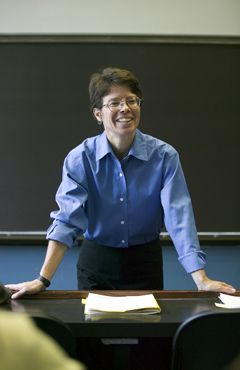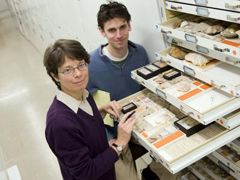How did the rise of cows in the Los Angeles watershed lead to the fall of scallops and clams in offshore waters? Paleontologists can identify which shellfish species persisted and which perished by combining clues from fossil shells littering the seafloor with surveys of animals currently living in coastal waters. This comparison method opens a new window to examine historic human impacts on hidden underwater ecosystems just offshore.
Susan Kidwell, a professor of geophysical sciences at the University of Chicago, used this method to discover a previously undocumented mass shellfish extinction that occurred only 200 years ago off the coast of southern California.
Shellfish, like dinosaurs, leave behind their skeletons after they die. Paleontologists can determine the age of shells from clams, scallops, mussels, and snails, and measure how abundant they were in the past.
Kidwell worked with biologists in San Diego and compared living shellfish populations to the remains of dead species. They found that a suite of shellfish species, entirely different from the species present today, once dominated the underwater landscape. These dead shellfish species had relied on clear water; they couldn’t tolerate muddy water. They liked to grow on the sandy and rocky seafloor surfaces that extended far out from the shore in a habitat called the continental shelf.
These clear water-dependent shellfish started to go extinct around the 1820s to 1830s, and were completely gone by the early 1900s. The extinction timing corresponded to the start of ranching and livestock grazing in and around Los Angeles. Cows and other farm animals trampled down the earth, sending rain flowing over the land instead of soaking in. The runoff carried soil into streams, estuaries and coastal waters, ultimately choking out the shellfish species that thrived in clear waters.
Kidwell presented her work on live-dead shell comparisons at the February 2017 meeting of the American Association for the Advancement of Science in Boston. Afterward, SciCom’s Emma Hiolski sat down with her to dig into the fossil record’s potential to reveal the recent past.
What inspired you to pursue paleobiology, especially with this conservation angle?
I proceeded with the first couple decades of my career as a rock hammer-carrying geologist in the field. But I was very interested in studies comparing skeletal debris in modern environments to the local live [samples].
As a result of my work on that, a friend of mine, who also had started in the fossil record but moved into modern environments, invited me to be on an ecological working group on historical over-fishing. Archaeologists and card-carrying ecologists were in this group of around 25 or 26 individuals. [We wrote a] famous 2001 paper in Science on the unappreciated role of over-fishing on altering coastal ecosystems, in fact collapsing them.
That was a life-changing experience for me. It was an amazing tutorial for me in ecology. And I hadn't felt like that since my first Earth Day, because it was about making a difference and looking at societally relevant issues. We were using historical and geo-historical data, but applied to societally important issues. So most of my work in the last 15 years has been how we use young fossil records to see into the recent ecological past.
And how did the project you presented today get started?
I started this in 2005. I had a former graduate student who was getting married in San Diego, so my husband and I were flying out for the wedding. And just a couple weeks before, I had gotten a reprint request for one of my papers about fossils in Southern California from a biologist with the city of San Diego. So I said, "I'm happy to send you a reprint of the paper, but if you don't mind, why does the City of San Diego have a biologist on the payroll?"
And he said, "That's because we do ocean modeling and monitoring of the [seafloor]. We're out there twice a year sampling, and we have to know how to identify all these animals."
Within a week, I was on the phone and asking, "What do you do with the skeletal debris?" They said, "We throw it out." I said nothing. They asked, "Would you like it?" And I said, "Yes."
"How soon can you get out there? Because I just told people they could throw it out."
"A week?"
"Sure! I'll tell them to not throw it out."
So I came out with the bride [laughs] and spent several days collecting the first set.
Did anything surprise you?
We were completely nonplussed to find that this community [of clear-water shellfish] had only gone extinct 200 years ago. We were sure we hadn't had [these animals] out there for thousands of years. And it turns out [their extinction] has all been within the last 200 years. I think it's important because we really have ratcheted things to some new normal.
"The nickname for this story became, ‘The Trouble with Dribbles,’ which of course doubled us over."
What does the coastal seafloor look like now?
You would have sands and exposed rocks in the first, shallowest part. In Southern California, those exposed rocks support the holdfasts of kelp, and the whole ecosystem of the kelp forest, as well as all kinds of other organisms that live on and in the sand in between. The next belt of water depth, the middle shelf, would be a patchwork of sand, and muddy sand, because it's quieter and some mud is allowed to come to rest. And as you get into deeper water you tend to get more exclusively mud and lose the sand component.
What are some other ways you can use this shell comparison method?
We had a project suggested by [Ron], a biologist at the City of San Diego: “We have [seafloor] features we can see on side-scan sonar that we think are dredge spoil that's been dumped outside the area set by the EPA. Would you be able to figure out whether or not it's dredge spoil?”
I said, "Absolutely!" Because it's sourced in San Diego Bay, so the shell material is going to be from bay-dwelling species, which are very distinctive from the clams and snails that live on the open shelf.
So maybe some enforcement implications?
Yes. It became a senior project by one of the undergrads at the University of Chicago. [At the time] I asked, "So how do [the dredge ships] do this, Ron? They're just sort of dribbling it out?"
He said, "Dribble? They just open. Sue, this is thousands of tons at a time!" So the nickname for this story became, "The Trouble with Dribbles," which of course doubled us over. Even the undergrads get that joke. [Laughs]
Did anything about that project surprise you?
Well, when you look at the death assemblages in the Bay, they have bay-dwelling species and they also have shells of invasive clams that only arrived in the last few decades. It turns out that the shells of invasive [species] are not present on the open continental shelf. As a result, although it's an argument by absence, we think we can not only identify these as dredge spoil dumps, but [also identify] whether they were dumped before the 1970s because they wouldn’t have these invasive [species]. Therefore, they were pre-regulation, and technically not illegal.
As you said in your talk, conservation paleobiology is a recently established field. What are some challenges of working in a new field?
It's not clear where we go for funding. If you ask the geologists to fund a project to answer a biological question, they say, "Go get the biologists to pay for it! We have very limited money." You go to the biologists and they say, "I've never heard of these methods," or "I'm not sure that this method is reliable yet, I can't judge." So it's very hard for them to rank highly something that's out of their expertise.
I'm still getting my funding for this by going to the geologists and focusing on the methodological issues and the geological values. But it would be nice to get funding for postdocs who are really card-carrying ecologists and restoration types.
Where do you hope your work goes in the future?
I am publishing papers on the academic geology side, and as guides to paleontologists. But what I'm now trying to do is write the papers and publish them in journals where applied ecologists and agency people will find them.
What do you think are some new and exciting things about your findings?
From a methodological perspective, [with geology] you start thinking about having a ship big enough, having special gear, all these things that are involved with coring. I'm talking about just using the core top. It is fast, it is cheap, there's no new fieldwork. I'm really pleased with how powerful this approach is going to be.
And I love the fact that now, 10 years in, we're beginning to actually get answers to some of the questions that the biologists thought we could help them with. That in fact the mud is completely not natural. Having that much mud is not natural, it has nothing to do with wastewater piping, and it happened a century before the area was even urbanized. They're surprised, but they love it.
I didn't want to give my talk without some positive things about what has been achieved with improved wastewater treatment since the Clean Water Act. I brought two of the L.A. County wastewater biologists with me on a cruise when we went to core, because I knew they'd just be wonderful sources of information. It was my way of thanking them, too. It's sort of on people's bucket list, if you're a biologist, to go on a cruise.
Absolutely.
And over the years, the seabed is becoming firmer, in part because it has less and less of this soupy mud. There's a whole series of observations they're making that are really great news. Nonetheless, I can still tell them that they still have far too few deposit feeders. We know what clams they need to be watching for, and when they will know when they are actually back to a fully healthy ecosystem.
So, as a geologist, what’s on your bucket list?
What would make me most happy as a geologist is to see a true, genuine, matter-of-fact integration of paleontology, paleobiology and biology, so that students no longer thought it was weird—sort of what has happened with paleoclimatology. That field was created from nowhere. I would really like to see that because I think it's so important to bring this historical perspective on modern societal issues.
____________________
© 2017 Emma Hiolski. Layers of Emma’s stories have accumulated at www.emmahiolski.com.


